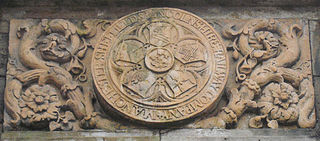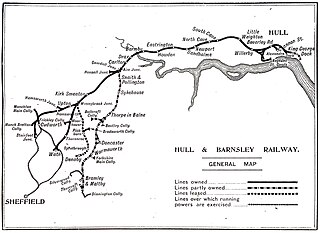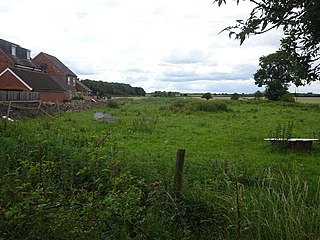
Conisbrough is a town within the City of Doncaster, in South Yorkshire, England. It is roughly midway between Doncaster and Rotherham, and is built alongside the River Don at 53°29′N1°14′W. It has a ward population of 14,333.

The Manchester, Sheffield and Lincolnshire Railway (MS&LR) was formed in 1847 when the Sheffield, Ashton-under-Lyne and Manchester Railway joined with authorised but unbuilt railway companies, forming a proposed network from Manchester to Grimsby. It pursued a policy of expanding its area of influence, especially in reaching west to Liverpool, which it ultimately did through the medium of the Cheshire Lines Committee network in joint partnership with the Great Northern Railway and the Midland Railway.

The Hull Barnsley & West Riding Junction Railway and Dock Company (HB&WRJR&DCo.) was opened on 20 July 1885. It had a total projected length of 66 miles but never reached Barnsley, stopping a few miles short at Stairfoot. The name was changed to The Hull and Barnsley Railway (H&BR) in 1905. Its Alexandra Dock in Hull opened 16 July 1885.
The South Yorkshire Railway was a railway company with lines in the West Riding of Yorkshire, England.

Denaby and Conisbrough railway station was a small station, the southern terminus of the South Yorkshire Junction Railway branch from Wrangbrook Junction. The station, built to serve Denaby Main and Conisbrough, near Doncaster, South Yorkshire, England, was situated just to the north of the Mexborough to Doncaster line of the Manchester, Sheffield and Lincolnshire Railway, close by the road linking the villages in its name. Access to the station was by a subway under the G.C. line.

Sprotborough (H&B) railway station was a small station on the South Yorkshire Junction Railway, which ran south from Wrangbrook Junction, where it joined the main line of the Hull and Barnsley Railway. It was situated between Denaby and Conisbrough and Pickburn and Brodsworth station.
The Dearne Valley Railway (DVR) was a railway line which ran through the valley of the River Dearne in South Yorkshire, England. It was incorporated by an Act of Parliament on 6 August 1897, which authorised the building of a line between Brierley Junction, on the main line of the Hull and Barnsley Railway, to junctions with the Great Northern Railway and the Great Northern and Great Eastern Joint Railway south-east of Doncaster.

The Hull and South Yorkshire Extension Railway was incorporated on 6 August 1897 and on 25 July 1898 was transferred to the Hull and Barnsley Railway. The bill was deposited by a group of local coal owners representing the Manvers Main Colliery Company, Hickleton Main Colliery, Wath Main Colliery, Wharncliffe Silkstone Colliery together with representatives of the Hull and Barnsley Railway.

Pickburn and Brodsworth railway station was a small railway station situated on the South Yorkshire Junction Railway's line between Wrangbrook Junction and Denaby and Conisbrough. It was situated 4.5 miles (7.2 km) south of Wrangbrook Junction, just inside what became the South Yorkshire boundary and was intended to serve the hamlet of Pickburn, which was close by, and Brodsworth, near Doncaster, South Yorkshire, a short distance away.

Denaby Main is a village situated between Mexborough and Conisbrough in the Metropolitan Borough of Doncaster in South Yorkshire, England. The village falls within the Doncaster MBC ward of Conisbrough and Denaby. It was built by the Denaby Main Colliery Company to house its workers and their families, and originally given the name Denaby Main Colliery Village, to distinguish it from the village of Denaby, about ⅔ mile away on the road to Hooton Roberts and Kilnhurst; from that time, the old village became known as Old Denaby. In due course the "Colliery Village" part of the name was lost, leaving the village to be known as Denaby Main.

The West Riding and Grimsby Railway was a railway company that promoted a line between Wakefield and Doncaster, in Yorkshire, England. There was also a branch line connection from Adwick le Street to Stainforth, which gave access towards Grimsby. The company was promoted independently, but it was sponsored by the Manchester, Sheffield and Lincolnshire Railway and the Great Northern Railway, and became jointly owned by them.

The Barnsley Coal Railway was a short railway which, when fully opened, ran between Stairfoot Junction, on the Mexborough to Barnsley line of the South Yorkshire Railway (SYR) and a triangular junction at Nostell on the line of the West Riding and Grimsby Railway (WR&GR).
The Great Central and Midland Joint Railway, formerly, before 1897, Sheffield and Midland Railway Companies' Committee, was a collection of joint railways, mainly in the Manchester and South Yorkshire areas.

Wrangbrook Junction near Upton in West Yorkshire was a location where two lines branched off the Hull and Barnsley Railway main line from Hull Cannon Street to Cudworth. The first junction led to Denaby and Conisbrough on the South Yorkshire Junction Railway, and after some four chains further the Hull & South Yorkshire Extension Railway to Wath diverged. The line between Hull and Cudworth had opened on 20 July 1885, the branch to Denaby on 1 September 1894 and the one to Wath on 31 March 1902.
The Hull and Barnsley and Great Central Joint Railway was a joint line which ran from Aire Junction, on the main line of the Hull and Barnsley Railway, near Gowdall to the Great Central and Midland Joint Railway at Braithwell Junction.

Kirk Smeaton railway station is located on the east side of Willowbridge Road in Little Smeaton, North Yorkshire, England. It opened on 22 July 1885, two days after the Hull Barnsley and West Riding Junction Railway and Dock Company opened the line between Hull Cannon Street and Cudworth. The station had two facing platforms, the brick-built main station building in "domestic revival style" was on the down side, while the up platform had a waiting room. At the east end of the down platform was a signal box which controlled the goods yard. The latter consisted of four sidings, but had no goods shed.
The Cadeby Main Pit Disaster was a coal mining accident on 9 July 1912 which occurred at Cadeby Main Colliery in Cadeby, West Riding of Yorkshire, England, killing 91 men. Early in the morning of 9 July an explosion in the south-west part of the Cadeby Main pit killed 35 men, with three more dying later due to their injuries. Later in the same day, after a rescue party was sent below ground, another explosion occurred, killing 53 men of the rescue party.
The Hull and Doncaster Branch is a secondary main railway line in England, connecting Kingston upon Hull to South Yorkshire and beyond via a branch from the Selby Line near Gilberdyke to a connection to the Doncaster–Barnetby line at a junction near Thorne 8 miles north-east of Doncaster.
The East and West Yorkshire Union Railway was promoted in 1883 to connect the Hull and Barnsley Railway at Drax with Leeds. The company was unable to raise the money it needed to build the line, and it substantially reduced its scope to connecting collieries around Rothwell with the existing main line network nearby. This was successful, with trains running from 1890, but the company decided it would find a way to connect to Leeds and operate a much truncated passenger service, from Rothwell. It sponsored the South Leeds Junction Railway to make a connection from Rothwell to the Midland Railway at Stourton; the SLJR was soon re-absorbed by the E&WYUR. The passenger service started on 4 January 1904 but it was a disastrous failure, and it was soon withdrawn from 1 October 1904.

Conisbrough Viaduct is a former railway viaduct, near to Cadeby and Conisbrough in South Yorkshire, England. The viaduct consists of two sections of brick and stone on each bank, connected by a lattice girder section, some 113–116 feet (34–35 m) over the River Don. The height and space were required should shipping need to navigate along the river. The viaduct carried the Dearne Valley Railway over the River Don between 1909 and 1966, after closure it was converted into a foot and cycle path. The structure is grade II listed, and is notable for being one of the first bridges in Britain to be built using a rope system above the viaduct known as a "Blondin".












